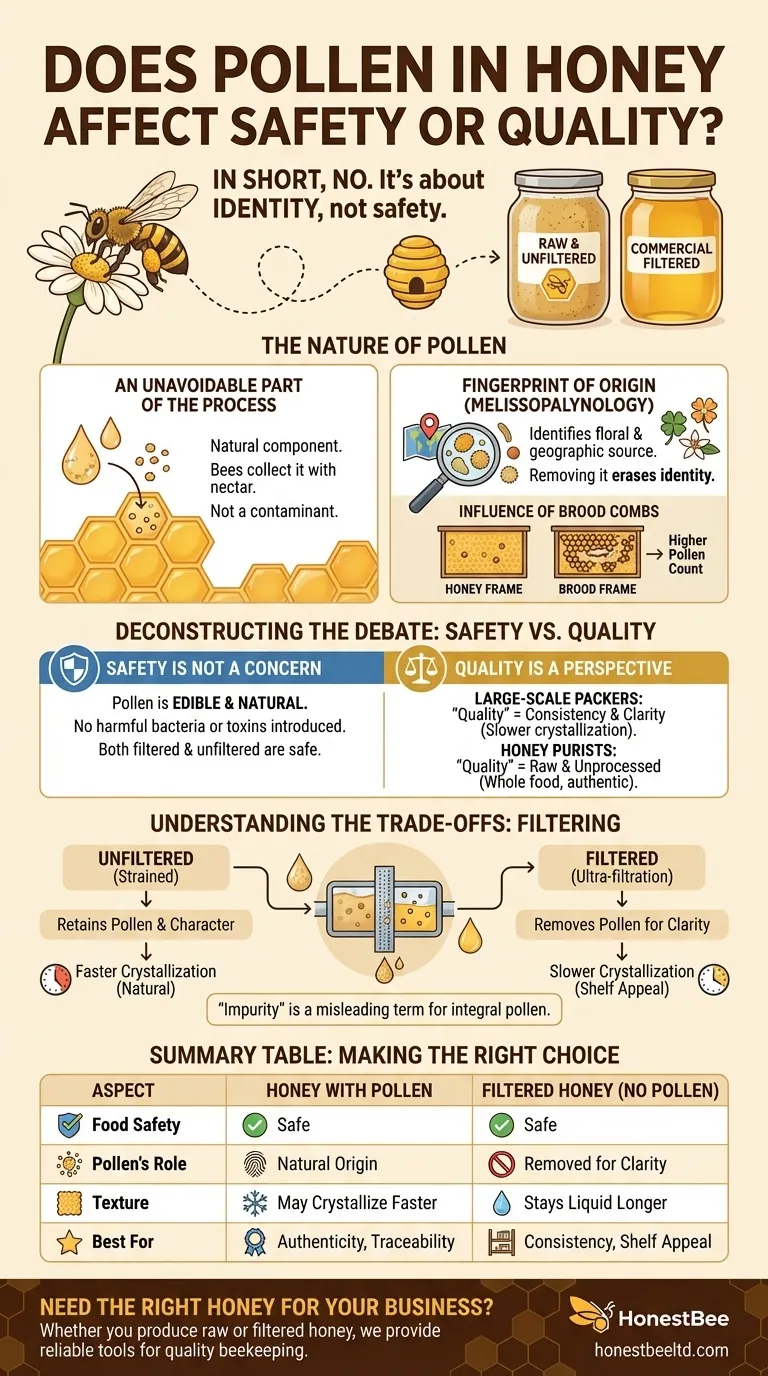In short, no. The presence or absence of pollen in honey does not affect its food safety. It is a natural component of honey, and its concentration primarily reflects the beekeeper's harvesting methods, not a risk to your health.
The real question isn't about safety, but about what pollen represents. It is the natural fingerprint of the honey's floral and geographic origin, not a contaminant or an indicator of poor quality.

How Pollen Ends Up in Honey
An Unavoidable Part of the Process
Honey begins as nectar that bees collect from flowers. As a bee gathers nectar, pollen from the flower's stamen inevitably sticks to its body and gets mixed into the collected nectar.
This pollen-laced nectar is then carried back to the hive, where it is transformed into honey. Therefore, the presence of pollen is a fundamental characteristic of authentic honey.
The Influence of Brood Combs
Beekeepers use frames within the hive for bees to build their wax comb. Some frames are used exclusively for storing honey, while others are used for raising young bees (the brood).
Brood combs naturally contain a higher concentration of stored pollen, as it is a primary food source for developing bees. If a beekeeper extracts honey from frames that also held brood, that honey will likely have a higher pollen count.
Deconstructing "Quality" vs. "Safety"
Safety is Not a Concern
Pollen is an edible and natural food product. Its presence in honey does not introduce any harmful bacteria or toxins. From a food safety standpoint, honey with or without pollen is perfectly safe for consumption (with the known exception for infants under one year of age due to botulism risks unrelated to pollen).
Pollen as a Fingerprint of Origin
The scientific analysis of pollen in honey, called melissopalynology, is the primary method used to verify a honey's origin.
By identifying the types of pollen present, experts can determine the specific plants the bees visited and the geographical region where the honey was produced. Removing the pollen effectively erases the honey's identity.
"Quality" is a Matter of Perspective
For large-scale honey packers, "quality" often means consistency and clarity. Removing pollen through fine filtration helps achieve a uniform, crystal-clear product that is less likely to crystallize on the shelf.
For honey purists and many consumers, "quality" means raw and unprocessed. They seek out unfiltered honey specifically because it contains pollen and other natural constituents, believing it to be a more whole and authentic food.
Understanding the Trade-offs: Filtering and "Impurities"
Why Honey is Often Filtered
The main reason for filtering honey is commercial appeal. Filtering removes not just pollen but also tiny air bubbles, wax particles, and other microscopic solids.
This process slows down the natural phenomenon of crystallization, giving the honey a longer shelf life as a smooth, clear liquid, which many consumers prefer.
Is Pollen an "Impurity"?
While any substance other than pure sugar solution could technically be defined as an impurity, this is a misleading term for pollen in honey.
Pollen is an integral, characteristic component, not a foreign contaminant like dust or debris. It's more accurate to distinguish between straining (which removes large bits of wax and is done for almost all honey) and ultra-filtration (an industrial process that removes pollen).
Making the Right Choice for Your Goal
Ultimately, the choice between honey with or without pollen comes down to personal preference, not safety.
- If your primary focus is authenticity and origin: Choose raw, unfiltered honey, as its pollen content serves as a guarantee of its floral source.
- If your primary focus is clarity and a longer liquid state: Choose a clear, commercially filtered honey that is less prone to crystallization.
- If your primary focus is simply food safety: You can be confident that both filtered and unfiltered honey are equally safe to eat.
Choosing your honey based on its pollen content is simply a matter of preferring either its natural character or its commercial consistency.
Summary Table:
| Aspect | Honey with Pollen | Filtered Honey (No Pollen) |
|---|---|---|
| Food Safety | Safe | Safe |
| Pollen's Role | Natural fingerprint of origin | Removed for clarity |
| Texture | May crystallize faster | Stays liquid longer |
| Best For | Authenticity, traceability | Consistency, shelf appeal |
Need the Right Honey for Your Business?
As HONESTBEE, we supply premium beekeeping supplies and equipment to commercial apiaries and distributors. Whether you produce raw, unfiltered honey or clear, filtered honey, we provide the reliable tools for quality beekeeping.
Contact us today to discuss your wholesale needs and ensure your operation has the best equipment for success.
Visual Guide

Related Products
- Precision Honey Refractometer Instrument for Quality Assessment
- Natural Wood Honey Dipper for Tea Coffee and Desserts
- Easy Use Manual Stainless Steel Honey Press for Honey Comb
- HONESTBEE 3-Frame Manual Acrylic Honey Extractor
- 10L Stainless Steel Electric Honey Press Machine
People Also Ask
- What is a honey refractometer? The Essential Tool for Perfect Honey Quality
- What are the key steps to using a honey refractometer? Ensure Honey Quality & Prevent Fermentation
- What are the benefits of using a Pocket Digital Honey Refractometer? Achieve Precision & Speed in Honey Quality Control
- What are the key points for proper usage of a honey refractometer? Ensure Accurate Moisture Readings Every Time
- How does a honey refractometer work? Ensure Honey Quality & Harvest Readiness



















